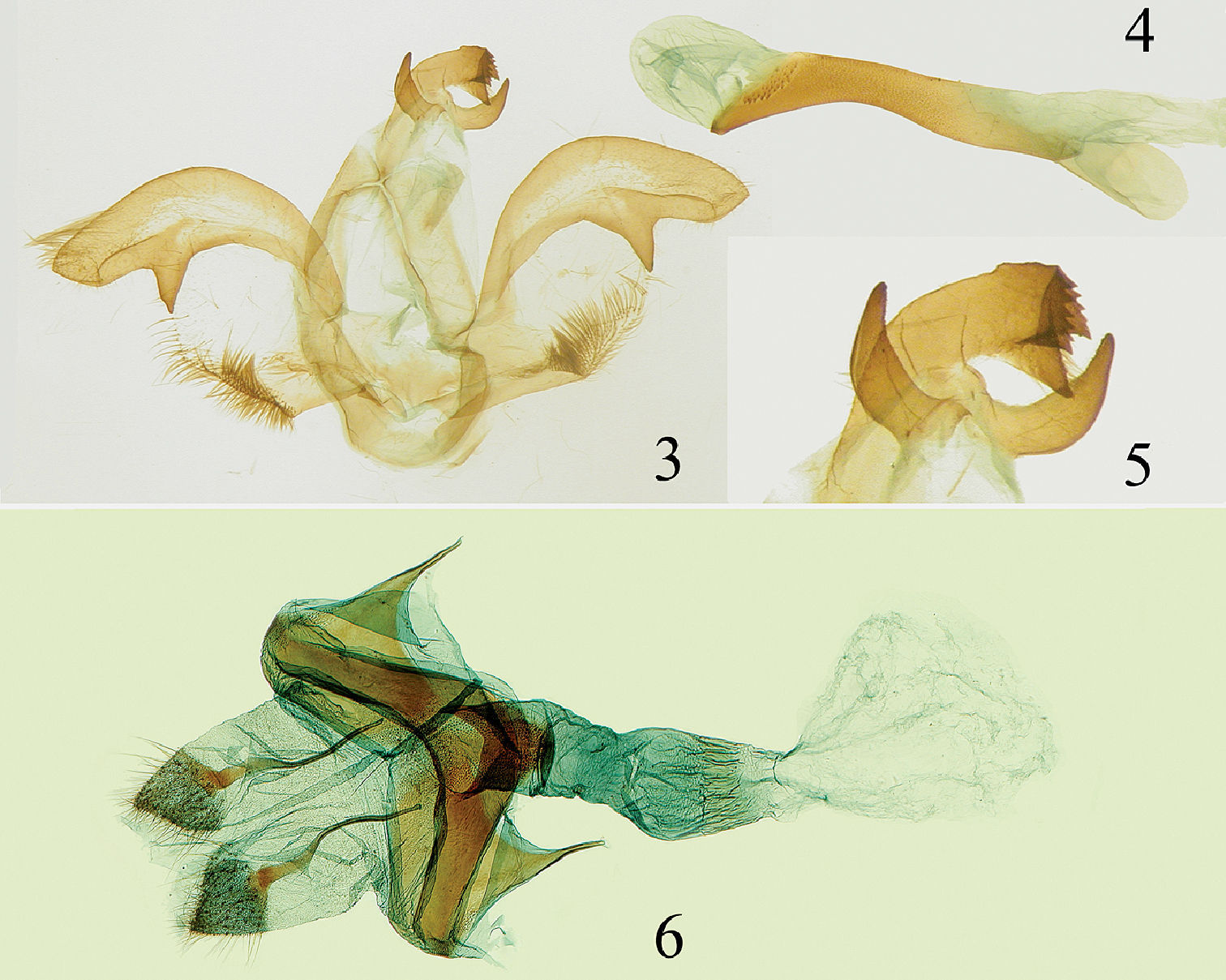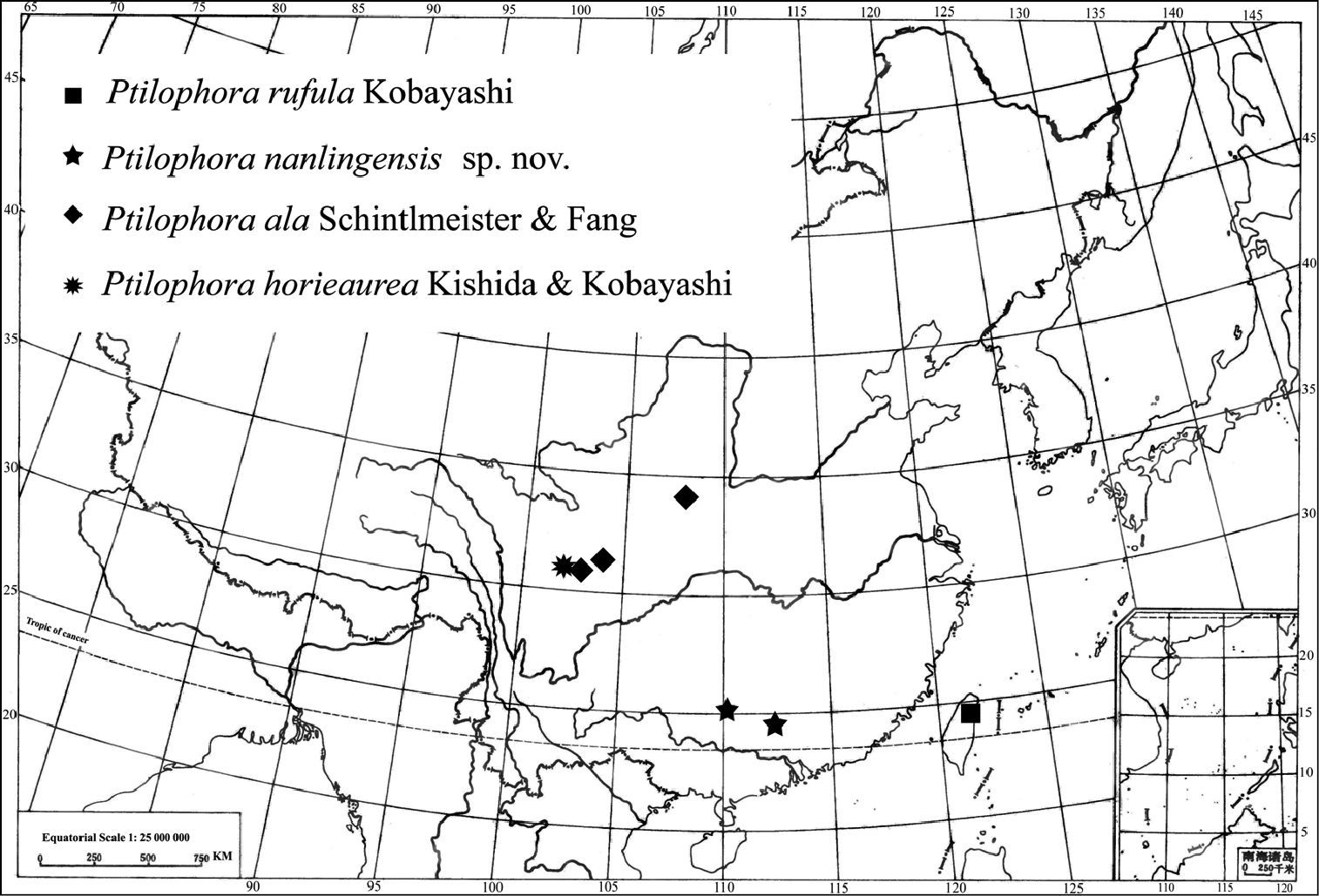(C) 2010 Liusheng Chen. This is an open access article distributed under the terms of the Creative Commons Attribution License, which permits unrestricted use, distribution, and reproduction in any medium, provided the original author and source are credited.
For reference, use of the paginated PDF or printed version of this article is recommended.
The genus Ptilophora Stephens in China is briefly reviewed, with the description of Ptilophora nanlingensis sp. n. The new species is most similar to Ptilophora horieaurea in wing pattern and to Ptilophora jezoensis in male genitalia, but they can be distinguished from each other by the following characters: forewing bright reddish brown in Ptilophora nanlingensis, chestnut brown in Ptilophora horieaurea; costa of male genitalia pointed, with a rounded subapical process ventrally in Ptilophora jezoensis, costa rounded, with apex inflated, and with pointed subapical process ventrally in Ptilophora nanlingensis. A key to the Ptilophora species from China and adjacent areas is presented and a distribution map is given. The holotype of the new species is deposited in the Department of Entomology, South China Agricultural University, P. R. China.
Lepidoptera, Notodontidae, Ptilophora, new species
The notodontid genus Ptilophora was established by Stephens in 1828 with Phalaena variegata
Villers, 1789 as its type species. Currently, the genus consists of
six species that are distributed in Europe (except northern Europe and
the Iberian Peninsula), Caucasus, Asia minor, China, Far East
Russia, Korea and Japan (
| 1 | Antenna black; forewing with a prominent discal spot; median fascia of hindwing blackish; male genitalia with rounded valve | 2 |
| – | Antenna brown to chestnut brown; forewings without prominent discal spot, median fascia of hindwing whitish or absent; male genitalia with irregular valves | 3 |
| 2 | Postmedian fascia of forewing is angled at M1; male genitalia with broad uncus, valve with a large harpe | Ptilophora nohirae |
| – | Postmedian fascia of is not angled at M1; uncus of male genitalia narrow, valve with a small triangular harpe | Ptilophora rufula |
| 3 | Color of forewing distal to postmedian fascia darker than basal and median areas of forewing; postmedian fascia distinct whitish, uniform from costal margin to inner margin | Ptilophora ala |
| – | Color of forewing distal to postmedian fascia similar to basal and median areas of forewing; postmedian fascia enlarged into white wedge-shaped spot at costal margin | 4 |
| 4 | Forewing pale reddish brown, with two distinct rather straight whitish fasciae | Ptilophora jezoensis |
| – | Forewing reddish brown to chestnut brown, basal fascia indistinct | 5 |
| 5 | Ground color of forewing uniformly bright reddish brown; a dusting of pale blue-gray scales in median and terminal areas of forewing; postmedian fascia white in costal area; frons near base of antennae with whitish hairs; thorax with similar long hairs at base of forewing; uncus with a triangular ventral-middle process, lateral processes serrated; valve with a triangular ventral process subapically | Ptilophora nanlingensis sp. n. |
| – | Ground color of forewing chestnut brown; postmedian fascia yellowish brown in costal area; frons, thorax, and abdomen with yellowish-brown hairs; uncus with blunt ventral-middle process, lateral processes with smooth margins; valva with a rounded ventral process subapically | Ptilophora horieaurea |
This species can be distinguished by the postmedian fascia of the forewing, which is distinctly whitish, and the darker shading beyond the postmedian fascia.
China (Shaanxi and Sichuan Provinces).
This species can be distinguished by external characters: frons, thorax, and abdomen covered with yellowish-brown hairs, the postmedian fascia is covered with yellowish brown in the posterior and costal areas.
China (Sichuan Province).
urn:lsid:zoobank.org:act:DA4A2641-4B7C-4102-BAE7-28578EB7E833
Figs 1–6The new species belongs to the Ptilophora jezoensis species group based on the wing pattern and male genital structure: forewing with distinct, whitish postmedian fascia, costa inflated and angulated apically. In the wing pattern, it seems to be closely related to Ptilophora horieaurea, whereas the male genital structures seem closer to those of Ptilophora jezoensis, but the two species can be distinguished from each other by the following characters: forewing bright reddish brown in Ptilophora nanlingensis, chestnut brown in Ptilophora horieaurea; uncus three-dimentional, and the costa of the valve with a rounded subapical ventral process in Ptilophora jezoensis, uncus three-dimensional, bifurcated apically, with serrated edges, and costa of valve rounded with apex inflated and with pointed subapical ventral process in Ptilophora nanlingensis (see Figs 3-5).
Adults of Ptilophora nanlingensis sp. n. 1 male adult 2 female adult.
Male. Forewing length 15–18 mm. Antenna plumose, about 0.5 x length of forewing, with yellowish-white hairs at base. Thorax and abdomen with dark reddish-brown hair. Forewing ground color from bright reddish brown to fuscous brown; chocolate toward costal and posterior margins, fuscous in terminal area; antimedian fascia visible, straighter than postmedian fascia; postmedian fascia distinct, whitish, slightly convex at vein M1, forming a triangular whitish spot at costa, brighter at veins; outer margin with ground color covered with pale blue-gray scales; cilia dark brown. Hindwing fuscous; postmedial fascia absent, a whitish spot near tornus, cilia from apex to middle of outer margin yellowish brown, fuscous brown toward tornus.
Female. Similar to male except forewing length 17 mm (n=1); antenna filiform; vertex, thorax and forewing uniform fuscous brown, abdomen yellowish brown.
Male genitalia. Uncus three-dimensional, bifurcated apically, with serrated edges; a long triangular ventral process derive from middle of branches, smooth ventrally, slightly serrated dorsally. Socii heavily sclerotized with two horn-shaped processes. Tegumen short and broad. Valva broad with a large triangular subapical process ventrally; costa rounded with apex inflated, cucullus quadrangular; sacculus with a triangular central process, with dense setae from middle to apex. Aedeagus slender, slightly curved dorsally near caudal end, carina penis serrated dorsally.
Female genitalia. Papilla analis rather broad, covered with thin hairs; the apophysis anterior shorter than apophysis posterior; ostium wide, well sclerotized; ductus bursae very lightly sclerotized, inflated mesially; corpus bursae small, membranous.
Genital structure of Ptilophora nanlingensis sp. n. 3 valva 4 aedeagus 5 uncus 6 female genitalia.
Male, Nanling, Shaoguan, Guangdong, China, 15.XII.2008, Hou-Shuai Wang leg.. Deposited in the Department of Entomology, South China Agricultural University, Guangzhou, P. R. China.
1 female, Nanling, Shaoguan, Guangdong, China, 21.IX.2006, Min Wang leg.; 3 males, Nanling, Shaoguan, Guangdong, China, 2.XII.2007, Liu-Sheng Chen leg.; 3 males, 3.XII.2008, Liu-Sheng Chen and Hou-Shuai Wang leg., Nanling, Shaoguan, Guangdong, China; 1 male, 10.XII.2009, Hou-Shuai Wang leg., Nanling, Shaoguan, Guangdong, China. Deposited in the Department of Entomology, South China Agricultural University, Guangzhou, P. R. China. 2 males, 1 female, Yuecheng Ling, Guangxi, China, 1800 m, 26°06'N; 110°54'E, 5–8.XII.2007, Viktor Siniaev leg. Deposited in coll. A. Schintlmeister, Dresden.
The specific name is derived from the type locality: Nanling Nature Reserve, Shaoguan City, Guangdong Province.
Bionomics. The moths were collected at light near 10°C the late autumn.
The adults of Ptilophora emerge late autumn, some species even flying at temperatures near 0°C (
We are greatly indebted to Dr. Mamuru Owada (National Science Museum, Tokyo, Japan), Mr. Yasunori Kishida and Dr. Hideki Kobayashi (Tokyo, Japan) for their kind suggestions and help with the manuscript. Our thanks also go to Mr. Yue-Ning Gong (the director of the Nanling National Reserve, China), Mr. He-Shan Chen, Mr. Guo-Yi Wu, Mr. Hou-Shuai Wang and Mr. Yang Long (South China Agricultural University, China) for their welcome help in field work. The first author wishes to thank Dr. Alexander Schintlmeister (Germany) for his cordial support on his studies in many ways. research was partly by the ProvincNatural Science Foundation of Hunan, (no. 09JJ6028).









